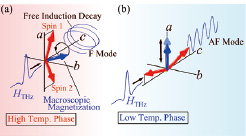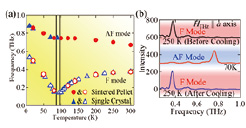Terahertz Time Domain Observation of Rotational Type Spin Reorientation Transition
Suemoto Group
Ultrafast coherent excitation of spins is one of the promising technologies for developments in spintronics and information processing. Such ultrafast control of the spin systems are often studied with pump and probe measurement using femtosecond visible laser [1]. Because these methods use indirect excitations of the spins that occur as a result of dielectric interaction with optical pulses, quite large amount of optical energy, typically 10 microjoule per pulse is required for pumping the spins. For this reason, unwanted electronic excitation and heating occurs. Instead, by using the terahertz pulses, spin precession motion can be excited directly through magnetic interaction between the terahertz magnetic component and the spin system [2, 3]. As described in Fig. 1, magnetic field component of the THz pulse instantaneously tilts the spins from their equilibrium orientation, causing the spins to precess around the effective magnetic field. Such motion of spins emits radiation which can be observed as free induction decay signal. With this technique, spin precession can be excited and observed simultaneously with a femtojoule terahertz pulse, which enables us to ignore the heating effect. In addition, owing to the low photon energy of the terahertz pulse, unwanted electronic excitation can be avoided.

Fig. 1. Illustration of ultrafast spin precession excitation with the magnetic field component of THz pulse parallel to the a-axis for (a) high temperature phase of ErFeO3, and (b) low temperature phase. In the high temperature phase, elliptically polarized emission from F mode resonance is observed. On the other hand, linearly polarized AF mode emission is observed in the low temperature phase. For the ease to see, the precessions of the individual Fe3+ spins 1 and 2 (red arrows) are omitted from the figures.

Fig. 2. (a) Temperature dependence of F and AF mode resonant frequencies in ErFeO3. Circle markers show frequencies obtained with the sintered pellet, and triangle markers show frequencies in a single crystal sample with (001) surface. Two vertical lines indicate higher and lower transition temperatures at 96 K and 87 K. (b) Intensity spectra of oscillatory components obtained with HTHz || a-axis THz pulse excitation.
Weak ferromagnet ErFeO3, which belongs to the rare earth orthoferrites known to have two magnetic resonance modes (Ferromagnetic mode and Antiferromagnetic mode) in sub-THz region [3], shows temperature induced spin reorientation transition. In this phase transition, the easy axis of the Fe3+ spins show 90 degree rotation. In the temperature range higher than 96 K (high temperature phase), the Fe3+ spins align antiferromagnetically toward the a-axis with a c-axis parallel macroscopic magnetization resulting from the canting of the spins (Fig. 1 (a)). At 87 K or lower (low temperature phase), the easy axis of the Fe3+ spins and the magnetization become parallel to the c-axis and a-axis, respectively (Fig. 1(b)).
Here, by focusing on the two magnetic resonance modes, we devised methods to observe the spin reorientation through THz time domain spectroscopy (TDS) and demonstrated this method with ErFeO3 [4]. The measurement was performed with a sintered pellet sample and a single crystal with a (001) surface. The temperature dependence of the two resonant frequencies is shown in Fig. 2(a). It shows that the F mode frequency drops significantly around the reorientation temperature. The spectra of radiation emitted from the spin precession excited with THz magnetic field parallel to a-axis shows that the frequency of the emission changes significantly between high temperature phase and low temperature phase (Fig. 2(b)). Comparing this with Fig. 2(a), it can be seen that the resonant frequency equals to F mode frequency for 250 K and AF mode for 70 K. Such switching of the excited mode can be explained by rotation of the easy axis due to the spin reorientation (Figs. 1(a) and (b)) and therefore, we have shown that spin reorientation can be detected through THz TDS measurement. To the best of our knowledge, this is the first observation of such phase transitions with THz time domain measurement. When observing this behavior in the temporal waveforms, half-cycle of the precession is sufficient for distinguishing F and AF modes. Thus, by focusing on the existence of the AF mode, the phase of the spin configuration can be determined with a resolution of 0.67 ps. Therefore, this method offers ability to detect spin reorientation with picosecond time resolution and it is expected to open the doorway for studying dynamics of ultrafast spin reorientation.
References
- [1] A. Kirilyuk, A. V. Kimel, and T. Rasing, Rev. Mod. Phys. 82, 2731 (2010).
- [2] M. Nakajima, A. Namai, S. Ohkoshi, and T. Suemoto, Opt. Exp. 18, 18260 (2010).
- [3] K. Yamaguchi, M. Nakajima, and T. Suemoto, Phys. Rev. Lett. 105, 237201 (2010).
- [4] K. Yamaguchi, T. Kurihara, Y. Minami, M. Nakajima, and T. Suemoto, Phys. Rev. Lett. 110, 137204 (2013).
